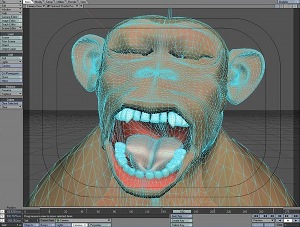Research
3D Animations

People empathize with fictional displays of behavior, including those in cartoons and computer animations, even though the displays are obviously artificial. Emotional engagement with characters is why we experience happiness, sadness, or any degree of suspense when watching something we know is not real. We tested whether chimpanzees also identify with virtual characters using a simple empathic response, contagious yawning. We believe that yawns are contagious for the same reason that other emotional responses, like smiles, frowns, and fear, are contagious. This hypothesis has been supported by recent research showing decreased contagious yawning in people with schizotypy and children with autism spectrum disorder—both associated with deficits in empathy. Animation is a potentially interesting tool because it offers control over variables we cannot control when presenting videotaped footage of behavior. Before we can apply this tool broadly, we need to know if chimpanzees will respond to animations as if they are watching real chimpanzees.
We presented chimpanzees with 3D computer animated chimpanzees yawning or making control mouth movements (see examples and details on the animation process below). The chimpanzees yawned significantly more in response to the animated yawns than they did to the animated control mouth movements, indicating that they identified with the animations and treated them almost as members of their own species. Studying why chimpanzees involuntarily mimic animations may help us to understand why children do the same.
The animation process
The animated chimpanzees were created by our affiliate Devyn Carter, who holds a degree in digital animation from the DAVE School (Digital Animation and Visual Effects, Universal Studios Florida), using Lightwave 3D (NewTek, Inc.) animation software.

The program consists of two main elements: “Modeler” and “Layout”. The images of the chimpanzees are formed in “Modeler”. Here, the geometry that comprises the images is formed via the use of a series of virtual tools designed to create an assortment of organic or inorganic objects such as animals, people, buildings, et cetera. Once the images have been assembled into virtual 3D objects, they can be accessed in “Layout” where the animator can begin adding a series of movements designed to simulate realistic behaviors or movements. This is accomplished by utilizing a complex set of virtual tools that denote how the object(s) will move and interact with the virtual environment.
Once the movements have been animated, a rendering process is established whereby the animated objects are transferred to digital media, thus creating the final animated scene for viewing. For additional questions about the animation process, please contact Mr. Carter directly at devyn.carter@emory.edu.
Below you may view some of the animations that we have used in contagious yawning research with chimpanzees.
Media coverage
BBC
The Daily Telegraph
Discovery News
The Wall Street Journal
Links
Frans de Waal discusses contagious yawning in an excerpt from his book The Age of Empathy, published in “Natural History” magazine.
http://www.naturalhistorymag.com/features/251555/sept
Yawning site maintained by Dr. Olivier Walusinski
http://baillement.com
First International Conference on Yawning
http://baillement.com/congress/ficy_index.html


